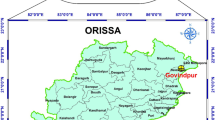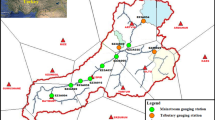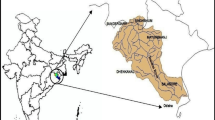Abstract
The free overfall is a simple and widely used device for measuring discharge in open irrigation channels and agricultural research projects. However, the direct measurement of discharge can be difficult and time-consuming with care needed to minimize potential inaccuracies of empirical equations applied to site-specific conditions. Thus, in the present study four standalone algorithms of Isotonic Regression (ISO), Least Median of Square Regression (LMS), M5Prime (M5P) and REPT and four novel hybrid algorithms of rotation forest (ROF) combined with those four standalone models (i.e., ROF-ISO, ROF-LMS, ROF-M5P and ROF-REPT) were applied for the intelligent prediction of discharge per unit width for the free overfall condition in rectangular channels. This was accomplished via six data sets (355 data) collected from the published literature including end depth, Manning's roughness coefficient, channel width, bed slope and unit discharge. The dataset was partitioned in a 70:30 ratio randomly, 70% (248 data) of data used for model development while 30% (107 data) applied for model validation. Also, four different input combinations were constructed to identify the most effective prediction method. Furthermore, results were validated using several visually based (line graph, scatter plot, violin plot and Taylor diagram) and quantitative-based [root mean square error (RMSE), Nash–Sutcliffe efficiency (NSE), Willmott’s index of agreement, Legates and McCabe coefficient of efficiency (LM)] approaches. Results of the sensitivity analysis revealed that end depth had the highest effect on the results, while channel width was least influential. Results also showed that the best input combination incorporated all four input parameters. According to the results, ROF-REPT had the best performance with RMSE of 0.0035 (m3/s/m), NSE of 0.990, WI of 0.997% and LM of 0.905% followed by ROF-M5P REPT, M5P, ROF-LMS, ISO and LMS.







Similar content being viewed by others
References
Abrahart RJ, Anctil F, Coulibaly P, Dawson CW, Mount NJ, See LM, Shamseldin AY, Solomatine DP, Toth E, Wilby RL (2012) Two decades of anarchy? Emerging themes and outstanding challenges for neural network river forecasting. Prog Phys Geogr 36:480–513. https://doi.org/10.1177/0309133312444943
Ahmad MW, Reynolds J, Rezgui Y (2018) Predictive modelling for solar thermal energy systems: A comparison of support vector regression, random forest, extra trees and regression trees. J Clean Prod 203:810–821. https://doi.org/10.1016/j.jclepro.2018.08.207
Ahmad Z, Azamathulla HM (2012) Quasi-theoretical end-depth-discharge relationship for trapezoidal channels. J Hydrol 456–457:151–155. https://doi.org/10.1016/j.jhydrol.2012.06.025
Ahmadi A, Han D, Lafdani EK, Moridi A (2015) Input selection for long-lead precipitation prediction using large-scale climate variables: A case study. J Hydroinformatics 17:114–129. https://doi.org/10.2166/hydro.2014.138
Ali KH, Sykes A (1972) Free-vortex theory applied to free overfalls. J Hydraul Div 98:973–979
Anastasiadou-Partheniou L, Hatzigiannakis E (1995) General end - depth - discharge relationship at free overfall in trapezoidal channel. J Irrig Drain Eng 121:143–151. https://doi.org/10.1061/(ASCE)0733-9437(1995)121:2(143)
Badar AM, Ghare A (2012) Development of discharge prediction model fort canals using simple portable flume. Int J Hydraul Eng 1:37–42
Barzegar R, Asghari Moghaddam A, Adamowski J, Fijani E (2017) Comparison of machine learning models for predicting fluoride contamination in groundwater. Stoch Environ Res Risk Assess 31:2705–2718. https://doi.org/10.1007/s00477-016-1338-z
Bui DT, Khosravi K, Karimi M, Busico G, Khozani ZS, Nguyen H, Mastrocicco M, Tedesco D, Cuoco E, Kazakis N (2020) Enhancing nitrate and strontium concentration prediction in groundwater by using new data mining algorithm. Sci Total Environ 715:136836. https://doi.org/10.1016/j.scitotenv.2020.136836
Bui DT, Khosravi K, Tiefenbacher J, Nguyen H, Kazakis N (2020) Improving prediction of water quality indices using novel hybrid machine-learning algorithms. Sci Total Environ. https://doi.org/10.1016/j.scitotenv.2020.137612
Bui DT, Pradhan B, Nampak H, Bui TQ, Tran A, Nguyen QP (2016) Hybrid artificial intelligence approach based on neural fuzzy inference model and metaheuristic optimization for flood susceptibility modelling in a high-frequency tropical area. J Hydrol 540:317–330. https://doi.org/10.1016/j.jhydrol.2016.06.027
Chen J, Wang X, Zhai J (2009) Pruning decision tree using genetic algorithms. Int Conf Artif Intell Comput Intell, AICI 2009:244–248. https://doi.org/10.1109/AICI.2009.351
Chen W, Panahi M, Khosravi K, Pourghasemi HR, Rezaie F, Parvinnezhad D (2019) Spatial prediction of groundwater potentiality using ANFIS ensembled with teaching-learning-based and biogeography-based optimization. J Hydrol 572:435–448. https://doi.org/10.1016/j.jhydrol.2019.03.013
Chen W, Panahi M, Pourghasemi HR (2017) Performance evaluation of GIS-based new ensemble data mining techniques of adaptive neuro-fuzzy inference system (ANFIS) with genetic algorithm (GA), differential evolution (DE), and particle swarm optimization (PSO) for landslide spatial modelling. CATENA 157:310–324. https://doi.org/10.1016/j.catena.2017.05.034
Choubin B, Darabi H, Rahmati O, Sajedi-Hosseini F, Kløve B (2018) River suspended sediment modelling using the CART model: A comparative study of machine learning techniques. Sci Total Environ 615:272–281. https://doi.org/10.1016/j.scitotenv.2017.09.293
Chung CJF, Fabbri AG (2003) Validation of spatial prediction models for landslide hazard mapping. Nat Hazards 30:451–472. https://doi.org/10.1023/B:NHAZ.0000007172.62651.2b
Davis AC, Ellett BGS, Jacob RP (1998) Flow measurement in sloping channels with rectangular free overfall. J Hydraul Eng 124:760–763. https://doi.org/10.1061/(ASCE)0733-9429(1998)124:7(760)
De’Ath G, Fabricius KE (2000) Classification and regression trees: A powerful yet simple technique for ecological data analysis. Ecology 81:3178–3192. https://doi.org/10.1890/0012-9658(2000)081[3178:CARTAP]2.0.CO;2
Delleur JW, Dooge JC, Gent KW (1956) Influence of slope and roughness on the overfall. J. Hydraul. Div. ASCE 82
Dey S (2002) Free overall in circular channels with flat base: A method of open channel flow measurement. Flow Meas Instrum 13:209–221. https://doi.org/10.1016/S0955-5986(02)00061-4
Diskin MH (1961) End depth at a drop in trapezoidal channels. J. Hydraul. Div. ASCE 87
Esposito F, Malerba D, Semeraro G (1997) A comparative analysis of methods for pruning decision trees. IEEE Trans Pattern Anal Mach Intell 19:476–491. https://doi.org/10.1109/34.589207
Ferro V (1999) Theoretical end-depth-discharge relationship for free overfall. J Irrig Drain Eng 125:40–44. https://doi.org/10.1061/(ASCE)0733-9437(1999)125:1(40)
Firat C (2004) Effect of roughness on flow measurements in sloping rectangular channels with free overfall. Middle East Tech Univ. https://doi.org/10.1017/CBO9781107415324.004
Goyal MK, Bharti B, Quilty J, Adamowski J, Pandey A (2014) Modeling of daily pan evaporation in sub tropical climates using ANN, LS-SVR, Fuzzy Logic, and ANFIS. Expert Syst Appl 41:5267–5276. https://doi.org/10.1016/j.eswa.2014.02.047
Hussain D, Khan AA (2020) Machine learning techniques for monthly river flow forecasting of Hunza River, Pakistan. Earth Sci Informatics. https://doi.org/10.1007/s12145-020-00450-z
ISO 3847 (1977) Liquid flow measurement in open channels by weirs and flumes — End-depth method for estimation of flow in rectangular channels with a free overfall
ISO 4371 (1984) Measurement of liquid flow in open channels by weirs and flumes — End depth method for estimation of flow in non-rectangular channels with a free overfall (approximate method)
Jahanpanah E, Khosravinia P, Sanikhani H, Kisi O (2019) Estimation of discharge with free overfall in rectangular channel using artificial intelligence models. Flow Meas Instrum 67:118–130. https://doi.org/10.1016/J.FLOWMEASINST.2019.04.005
Khosravi K, Barzegar R, Miraki S, Adamowski J, Daggupati P, Alizadeh MR, Pham BT, Alami MT (2019) Stochastic modeling of groundwater fluoride contamination: introducing lazy learners. Groundwater gwat. https://doi.org/10.1111/gwat.12963
Khosravi K, Cooper JR, Daggupati P, Thai Pham B, Bui DT (2020) Bedload transport rate prediction: Application of novel hybrid data mining techniques. J Hydrol 585:124774. https://doi.org/10.1016/j.jhydrol.2020.124774
Khosravi K, Daggupati P, Alami MT, Awadh SM, Ghareb MI, Panahi M, Pham BT, Rezaie F, Qi C, Yaseen ZM (2019) Meteorological data mining and hybrid data-intelligence models for reference evaporation simulation: A case study in Iraq. Comput Electron Agric. https://doi.org/10.1016/j.compag.2019.105041
Khosravi K, Panahi M, Tien Bui D (2018) Spatial prediction of groundwater spring potential mapping based on an adaptive neuro-fuzzy inference system and metaheuristic optimization. Hydrol Earth Syst Sci 22:4771–4792. https://doi.org/10.5194/hess-22-4771-2018
Khosravi K, Pham BT, Chapi K, Shirzadi A, Shahabi H, Revhaug I, Prakash I, Tien Bui D (2018) A comparative assessment of decision trees algorithms for flash flood susceptibility modeling at Haraz watershed, northern Iran. Sci Total Environ 627:744–755. https://doi.org/10.1016/j.scitotenv.2018.01.266
Khosravinia P, Nikpour MR, Kisi O, Yaseen ZM (2020) Application of novel data mining algorithms in prediction of discharge and end depth in trapezoidal sections. Comput Electron Agric. https://doi.org/10.1016/j.compag.2020.105283
Kisi O, Dailr AH, Cimen M, Shiri J (2012) Suspended sediment modeling using genetic programming and soft computing techniques. J Hydrol 450–451:48–58. https://doi.org/10.1016/j.jhydrol.2012.05.031
Kutlu I (2005) Scrutinizing rectangular free overfall. Middle East Technical University, Ankara, Turkey
Langbein WB (1937) Discharge over a free fall. Civ Eng ASCE 7:349–350
Legates DR, McCabe GJ (1999) Evaluating the use of “goodness-of-fit” measures in hydrologic and hydroclimatic model validation. Water Resour Res 35:233–241. https://doi.org/10.1029/1998WR900018
Mitchell TM (1999) Machine Learning and Data Mining. Commun ACM 42:30–36. https://doi.org/10.1145/319382.319388
Mohamed WNHW, Salleh MNM, Omar AH (2012) A comparative study of reduced error pruning method in decision tree algorithms. In: Control System, Computing and Engineering (ICCSCE), 2012 IEEE International Conference On. IEEE, pp. 392–397
Mohammed AY (2018) Artificial Neural Network (ANN) model for end depth computations. J Civ Environ Eng. https://doi.org/10.4172/2165-784x.1000316
Moriasi DN, Arnold JGJGJG, Van Liew MWMWMW, Bingner RL, Harmel RDD, Veith TLTLTLTL, Binger RL, Harmel RDD, Veith TLTLTLTL, Bingner RL, Harmel RDD, Veith TLTLTLTL (2007) Model evaluation guidelines for systematic quantification of accuracy in watershed simulations. Trans ASABE 50:885–900. https://doi.org/10.13031/2013.23153
Nampak H, Pradhan B, Manap MA (2014) Application of GIS based data driven evidential belief function model to predict groundwater potential zonation. J Hydrol 513:283–300. https://doi.org/10.1016/j.jhydrol.2014.02.053
Nash J, Sutcliffe JV (1970) River flow forecasting through conceptual models Part I-A discussion of principles. J Hydrol 10:282–290
Öztürk HU (2005) Discharge predictions using ann in sloping rectangular channels with free overfall. Middle East Technical University, Turkey
Paderi F (1961) Correnti in arrivo veloci in zona terminale di canale a forte pendenza prossima alla critica. L’Energia Elettr 38:874–881
Pal M, Goel A (2007) Estimation of discharge and end depth in trapezoidal channel by support vector machines. Water Resour Manag 21:1763–1780. https://doi.org/10.1007/s11269-006-9126-z
Pal M, Goel A (2006) Prediction of the end-depth ratio and discharge in semi-circular and circular shaped channels using support vector machines. Flow Meas Instrum 17:49–57. https://doi.org/10.1016/j.flowmeasinst.2005.05.003
Patel N, Upadhyay S (2012) Study of various decision tree pruning methods with their empirical comparison in WEKA. Int J Comput Appl 60:20–25. https://doi.org/10.5120/9744-4304
Pham BT, Tien Bui D, Prakash I, Dholakia MB (2016) Rotation forest fuzzy rule-based classifier ensemble for spatial prediction of landslides using GIS. Nat Hazards 83:97–127. https://doi.org/10.1007/s11069-016-2304-2
Pradhan B (2010) Remote sensing and GIS-based landslide hazard analysis and cross-validation using multivariate logistic regression model on three test areas in Malaysia. Adv Sp Res 45:1244–1256. https://doi.org/10.1016/j.asr.2010.01.006
Qasem SN, Samadianfard S, Kheshtgar S, Jarhan S, Kisi O, Shamshirband S, Chau KW (2019) Modeling monthly pan evaporation using wavelet support vector regression and wavelet artificial neural networks in arid and humid climates. Eng Appl Comput Fluid Mech 13:177–187. https://doi.org/10.1080/19942060.2018.1564702
Quinlan JR (1992) Learning with continuous classes. Mach Learn 92:343–348
Raikar RV, Nagesh Kumar D, Dey S (2004) End depth computation in inverted semicircular channels using ANNs. Flow Meas Instrum 15:285–293. https://doi.org/10.1016/j.flowmeasinst.2004.06.003
Rajaratnam N, Muralidhar D, Beltaos S (1976) Roughness effects on rectangular free overfall. ASCE J Hydraul Div 102:599–614
Ramamurthy AS, Qu J, Vo D (2006) VOF model for simulation of a free overfall in trapezoidal channels. J Irrig Drain Eng 132:425–428. https://doi.org/10.1061/(ASCE)0733-9437(2006)132:4(425)
Ramamurthy AS, Zhai C, Qu J (2004) End depth-discharge relation at free overfall of trapezoidal channels. J Irrig Drain Eng 130:432–436. https://doi.org/10.1061/(ASCE)0733-9437(2004)130:5(432)
Rodríguez JJ, Kuncheva LI, Alonso CJ (2006) Rotation forest: A New classifier ensemble method. IEEE Trans Pattern Anal Mach Intell 28:1619–1630. https://doi.org/10.1109/TPAMI.2006.211
Rohwer C (1943) Discharge of pipes flowing partly full. Civ Eng ASCE 13:488–490
Rouse H (1936) Discharge characteristics of the free overfall: use of crest section as a control provides easy means of measuring discharge. Civ Eng 6:257–260
Rouse H (1932) Verteilung der hydraulischen Energie bei einem lotrechten Absturz. TU Karlsruhe, Germany
Rousseeuw PJ (1984) Least median of squares regression. J Am Stat Assoc 79:871–880. https://doi.org/10.1080/01621459.1984.10477105
Rousseeuw PJ, Leroy AM (1987) Robust Regression and outlier detection, Wiley Online Library, Wiley Series in Probability and Statistics. Wiley: New York, USA. https://doi.org/10.1002/0471725382
Samadianfard S, Ghorbani MA, Mohammadi B (2018) Forecasting soil temperature at multiple-depth with a hybrid artificial neural network model coupled-hybrid firefly optimizer algorithm. Inf Process Agric 5:465–476. https://doi.org/10.1016/j.inpa.2018.06.005
Samadianfard S, Jarhan S, Salwana E, Mosavi A, Shamshirband S, Akib S (2019) Support vector regression integrated with fruit fly optimization algorithm for river flow forecasting in lake urmia basin. Water (Switzerland). https://doi.org/10.3390/w11091934
Samadianfard S, Majnooni-Heris A, Qasem SN, Kisi O, Shamshirband S, Chau KW (2019) Daily global solar radiation modeling using data-driven techniques and empirical equations in a semi-arid climate. Eng Appl Comput Fluid Mech 13:142–157. https://doi.org/10.1080/19942060.2018.1560364
Shamshirband S, Hashemi S, Salimi H, Samadianfard S, Asadi E, Shadkani S, Kargar K, Mosavi A, Nabipour N, Chau KW (2020) Predicting Standardized Streamflow index for hydrological drought using machine learning models. Eng Appl Comput Fluid Mech 14:339–350. https://doi.org/10.1080/19942060.2020.1715844
Sharifi S, Sterling M, Knight DW (2011) Prediction of end-depth ratio in open channels using genetic programming. J Hydroinformatics 13:36–48. https://doi.org/10.2166/hydro.2010.087
Sheikh Khozani Z, Bonakdari H, Zaji AH (2018) Estimating shear stress in a rectangular channel with rough boundaries using an optimized SVM method. Neural Comput Appl 30:1–13. https://doi.org/10.1007/s00521-016-2792-8
Sheikh Khozani Z, Bonakdari H, Zaji AH (2017) Efficient shear stress distribution detection in circular channels using Extreme Learning Machines and the M5 model tree algorithm. Urban Water J 14:999–1006. https://doi.org/10.1080/1573062X.2017.1325495
Sheikh Khozani Z, Bonakdari H, Zaji AH (2017) Estimating the shear stress distribution in circular channels based on the randomized neural network technique. Appl Soft Comput 58:441–448. https://doi.org/10.1016/j.asoc.2017.05.024
Sheikh Khozani Z, Khosravi K, Pham BT, Kløve B, Wan Mohtar WHM, Yaseen ZM (2019) Determination of compound channel apparent shear stress: application of novel data mining models. J Hydroinformatics 21:798–811. https://doi.org/10.2166/hydro.2019.037
Shirzadi A, Soliamani K, Habibnejhad M, Kavian A, Chapi K, Shahabi H, Chen W, Khosravi K, Pham BT, Pradhan B, Ahmad A, Bin Ahmad B, Bui DT (2018) Novel GIS based machine learning algorithms for shallow landslide susceptibility mapping. Sensors (Switzerland) 18:3777. https://doi.org/10.3390/s18113777
Smith CD (1962) Brink depth for a circular channel. J Hydraul Devision 88:125–134
Srinivasan D, Mekala P (2014) Mining social networking data for classification using reptree. Int J Adv Res Comput Sci Manag Stud, 2
Tao H, Keshtegar B, Yaseen ZM (2019) the feasibility of integrative radial basis M5Tree predictive model for river suspended sediment load simulation. Water Resour Manag 33:4471–4490. https://doi.org/10.1007/s11269-019-02378-6
Termeh SVR, Khosravi K, Sartaj M, Keesstra SD, Tsai FTC, Dijksma R, Pham BT (2019) Optimization of an adaptive neuro-fuzzy inference system for groundwater potential mapping. Hydrogeol J 27:2511–2534. https://doi.org/10.1007/s10040-019-02017-9
Thi Ngo PT, Panahi M, Khosravi K, Ghorbanzadeh O, Karimnejad N, Cerda A, Lee S (2020) Evaluation of deep learning algorithms for national scale landslide susceptibility mapping of Iran. Geosci Front. https://doi.org/10.1016/j.gsf.2020.06.013
Tien Bui D, Tuan TA, Klempe H, Pradhan B, Revhaug I (2016) Spatial prediction models for shallow landslide hazards: a comparative assessment of the efficacy of support vector machines, artificial neural networks, kernel logistic regression, and logistic model tree. Landslides 13:361–378. https://doi.org/10.1007/s10346-015-0557-6
Turan C (2002) Experimental studies on free overfall. Middle East Technical University, Ankara, Turkey
Vand AS, Sihag P, Singh B, Zand M (2018) Comparative evaluation of infiltration models. KSCE J Civ Eng 22:4173–4184. https://doi.org/10.1007/s12205-018-1347-1
Vatankhah AR (2013) Direct solution for discharge in generalized trapezoidal free overfall. Flow Meas Instrum 29:61–64. https://doi.org/10.1016/j.flowmeasinst.2012.09.006
Wang Y, Witten IH (1997) Induction of model trees for predicting continuous classes. Proc. 9th Eur. Conf. Mach. Learn. Poster Pap
Willmott CJ, Robeson SM, Matsuura K (2012) A refined index of model performance. Int J Climatol 32:2088–2094. https://doi.org/10.1002/joc.2419
Wold S, Esbensen K, Geladi P (1987) Principal component analysis. Chemom Intell Lab Syst 2:37–52
Yaseen ZM, Ebtehaj I, Bonakdari H, Deo RC, Danandeh Mehr A, Mohtar WHMW, Diop L, El-shafie A, Singh VP (2017) Novel approach for streamflow forecasting using a hybrid ANFIS-FFA model. J Hydrol 554:263–276. https://doi.org/10.1016/j.jhydrol.2017.09.007
Yaseen ZM, El-shafie A, Jaafar O, Afan HA, Sayl KN (2015) Artificial intelligence based models for stream-flow forecasting: 2000–2015. J Hydrol. https://doi.org/10.1016/j.jhydrol.2015.10.038
Yaseen ZM, Kisi O, Demir V (2016) Enhancing long-term streamflow forecasting and predicting using periodicity data component: application of artificial intelligence. Water Resour Manag 30:4125–4151. https://doi.org/10.1007/s11269-016-1408-5
Zounemat-Kermani M, Seo Y, Kim S, Ghorbani MA, Samadianfard S, Naghshara S, Kim NW, Singh VP (2019) Can decomposition approaches always enhance soft computing models? Predicting the dissolved oxygen concentration in the St, Johns River, Florida. Appl Sci 9 https://doi.org/10.3390/app9122534
Author information
Authors and Affiliations
Corresponding author
Ethics declarations
Conflict of interest
The authors do not have any conflicts of interest or financial disclosures to report.
Additional information
Publisher's Note
Springer Nature remains neutral with regard to jurisdictional claims in published maps and institutional affiliations.
Rights and permissions
About this article
Cite this article
Khosravi, K., Khozani, Z.S., M.Melesse, A. et al. Intelligent flow discharge computation in a rectangular channel with free overfall condition. Neural Comput & Applic 34, 12601–12616 (2022). https://doi.org/10.1007/s00521-022-07112-9
Received:
Accepted:
Published:
Issue Date:
DOI: https://doi.org/10.1007/s00521-022-07112-9




